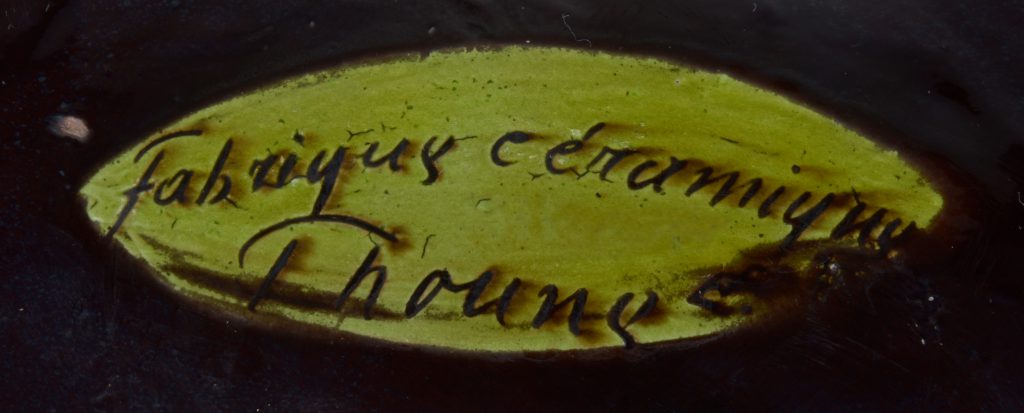

Andreas Heege 2019
Contrary to what the name suggests, “Thun majolica” is, in fact, earthenware with polychrome glazing, rather than majolica, which has a lead-tin glaze on one side only and in-glaze painted decoration. Many of the factories in the second half of the 19th century that produced lead-glazed earthenware with polychrome painted decoration, often in the form of historicising Renaissance motifs, erroneously referred to it as “majolica”.
“Thun majolica” had its roots in the local pottery production of Heimberg-Steffisburg and became popular in the late 19th and early 20th centuries, i.e. during the period of historicism in all its manifestations. Its beginnings date back to the 1870s. After it was introduced to the public at the 1878 world exhibition in Paris, it quickly became a successful product, stimulated further by the founding of the Wanzenried manufactory in Steffisburg (in 1878).
In 1908, Oscar Blom, the director of the Gewerbemuseum Bern wrote:
“Up to the mid-90s it would have been unthinkable [in Heimberg-Steffisburg] to pursue the development of a new decorative style of pottery. The ceramic forms and decorations that had been introduced by the Karlsruhe artist Keller-Leuzinger in the 70s and are still known today as ‘Paris ware’ had become so practised and so popular on the market that it would have been presumptuous to suggest making innovations. In architecture as in the decorative arts, the only option at the time was to reproduce either the styles from the past or those from the orient. The applied arts had not yet found their own vocabulary. Even Keller-Leuzinger, who made an outstanding contribution to the elevation of the Heimberg industry, only used Indian and Persian motifs in his ornamentation, albeit replacing the Indian flora with Alpine roses and edelweiss petals, thus creating completely new effects and ensuring an increase in majolica sales for many years to come. The 1893 world exhibition in Chicago, however, finally brought a reversal in the range of patterns used to decorate artisanal products and a change in people’s tastes. The new expectations for such objects included usefulness, convenience and good-quality materials combined with a solidity and simplicity in artistic expression.” These expectations were no longer fulfilled by Thun majolica vessels. Sales plummeted and numerous potters’ workshops that had been producing Thun majolica were forced to close down. According to Blom, the number of manufacturers dropped from 74 to 47 in the period between 1887 and 1907. The historicist style of Thun majolica had already outlived its popularity even before the outbreak of the First World War.
The acquisition of the Wanzenried manufactory in 1919 by Emil Loder and Adolf Schweizer can be seen as representing the style’s final demise. A further blow was the death in 1920 of the manufactory’s most important designer and ceramic painter, Friedrich Ernst Frank. Of course, various Thun majolica decorative elements and motifs continued to be used in numerous potters’ workshops throughout the Heimberg-Steffisburg region and also in Lucerne (Emil Loder, KeraLuz) in subsequent years. One was the Chrutmuster pattern, also known as the “Old Thun” pattern. Pottery in the “Thun majolica style” was also produced in varying degrees of quality, e.g. in Berneck, Canton of St. Gallen, Thayngen, Canton of Schaffhausen (Fritz Lenhard pottery) and Wil-Buchenloo, Canton of Zurich (Jakob Spühler pottery).
Translation Sandy Haemmerle
References:
Blom 1908
Oscar Blom, Die Förderung der Majolika-Industrie in Heimberg-Steffisburg-Thun durch das kantonale Gewerbe-Museum in Bern, in: Jahresbericht pro 1907 des kantonalen Gewerbemuseums Bern, 1908, 1-9.
Buchs 1980
Hermann Buchs, Die Thuner Majolika des Johannes Wanzenried und des Zeichners Friedrich Ernst Frank, in: Jahresbericht Historisches Museum Schloss Thun, 1980, 5-43.
Buchs 1988
Hermann Buchs, Vom Heimberger Geschirr zur Thuner Majolika, Thun 1988.
Heege/Kistler 2017
Andreas Heege/Andreas Kistler, Poteries décorées de Suisse alémanique, 17e-19e siècles – Collections du Musée Ariana, Genève – Keramik der Deutschschweiz, 17.-19. Jahrhundert – Die Sammlung des Musée Ariana, Genf, Mailand 2017, 489-501.
Schnyder 1979
Rudolf Schnyder, Jakob Spühler, der Töpfer von Wil/Buchenloo, in: Mitteilungsblatt der Keramikfreunde der Schweiz 92, 1979, 9-11.

